牛津常用英语词典Oxford Dictionary of Idioms
- 格式:pdf
- 大小:319.61 KB
- 文档页数:4
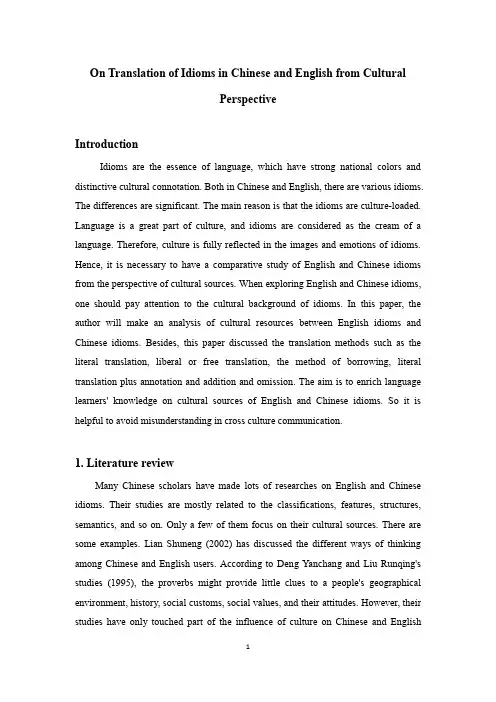
On Translation of Idioms in Chinese and English from CulturalPerspectiveIntroductionIdioms are the essence of language, which have strong national colors and distinctive cultural connotation. Both in Chinese and English, there are various idioms. The differences are significant. The main reason is that the idioms are culture-loaded. Language is a great part of culture, and idioms are considered as the cream of a language. Therefore, culture is fully reflected in the images and emotions of idioms. Hence, it is necessary to have a comparative study of English and Chinese idioms from the perspective of cultural sources. When exploring English and Chinese idioms,one should pay attention to the cultural background of idioms. In this paper, the author will make an analysis of cultural resources between English idioms and Chinese idioms. Besides, this paper discussed the translation methods such as the literal translation, liberal or free translation, the method of borrowing, literal translation plus annotation and addition and omission. The aim is to enrich language learners' knowledge on cultural sources of English and Chinese idioms. So it is helpful to avoid misunderstanding in cross culture communication.1. Literature reviewMany Chinese scholars have made lots of researches on English and Chinese idioms. Their studies are mostly related to the classifications, features, structures, semantics, and so on. Only a few of them focus on their cultural sources. There are some examples. LianShuneng (2002) has discussed the different ways of thinking among Chinese and English users. According to Deng Yanchang and Liu Runqing's studies (1995), the proverbs might provide little clues to a people's geographical environment, history, social customs, social values, and their attitudes. However, their studies have only touched part of the influence of culture on ChineseandEnglishidioms. But they have not made systematic studies on idioms from the perspective of cultural sources. In this paper, the author will analyze the idioms from cultural aspects.2. Definition of IdiomsIn most languages, there are idioms. However, in different languages, the ranges and forms of idioms are not the same. Even in a certain kind of language, such as English, there are many different kinds of definitions for“idiom”. So it is very hardto give a preciseand widely accepted definition of “idiom”. There are basic criteria to decide whether anexpression is an idiom or not. Firstly, an idiom mustbewell-established and acceptedthrough common practice; secondly, an idiom usually has an implied meaning. Sogenerally speaking, an idiom is expressions, which is a term or phrase or sentence whosemeaning cannot be deduced from the literal definitions and the arrangement of its parts. It can be known from the commonually some peoplewould natural ly associate "idiom” with “chengyu” and they think that idiom is the equivalent of“chengyu”. In fact, English idioms and "chengyu”are not equivalent. It is more similar to that of "shuyu" in Chinese. We may find thatthey share quite a lot of common features. So they are corresponding linguistic and cultural phenomena. We can use with a contrastive approach to study them. In New Oxford Dictionary of English, (1998) idioms are a group of words established by usage as having a meaning not deducible from those of the individual words.In Ci-ha i (1999), “shuyu” is defined as“熟语是语言中定型的词组或者词句,使用时一般不能改变其组织。
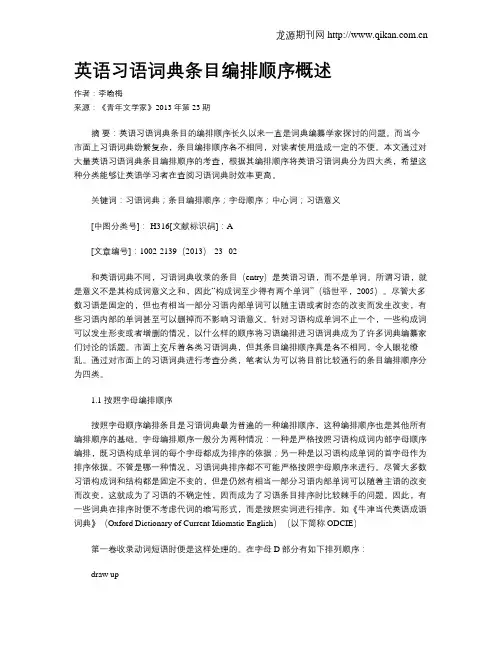
英语习语词典条目编排顺序概述作者:李喻梅来源:《青年文学家》2013年第23期摘要:英语习语词典条目的编排顺序长久以来一直是词典编纂学家探讨的问题。
而当今市面上习语词典纷繁复杂,条目编排顺序各不相同,对读者使用造成一定的不便。
本文通过对大量英语习语词典条目编排顺序的考查,根据其编排顺序将英语习语词典分为四大类,希望这种分类能够让英语学习者在查阅习语词典时效率更高。
关键词:习语词典;条目编排顺序;字母顺序;中心词;习语意义[中图分类号]: H316[文献标识码]:A[文章编号]:1002-2139(2013)-23--02和英语词典不同,习语词典收录的条目(entry)是英语习语,而不是单词。
所谓习语,就是意义不是其构成词意义之和,因此“构成词至少得有两个单词”(骆世平,2005)。
尽管大多数习语是固定的,但也有相当一部分习语内部单词可以随主语或者时态的改变而发生改变,有些习语内部的单词甚至可以删掉而不影响习语意义。
针对习语构成单词不止一个,一些构成词可以发生形变或者增删的情况,以什么样的顺序将习语编排进习语词典成为了许多词典编纂家们讨论的话题。
市面上充斥着各类习语词典,但其条目编排顺序真是各不相同,令人眼花缭乱。
通过对市面上的习语词典进行考查分类,笔者认为可以将目前比较通行的条目编排顺序分为四类。
1.1 按照字母编排顺序按照字母顺序编排条目是习语词典最为普遍的一种编排顺序,这种编排顺序也是其他所有编排顺序的基础。
字母编排顺序一般分为两种情况:一种是严格按照习语构成词内部字母顺序编排,既习语构成单词的每个字母都成为排序的依据;另一种是以习语构成单词的首字母作为排序依据。
不管是哪一种情况,习语词典排序都不可能严格按照字母顺序来进行。
尽管大多数习语构成词和结构都是固定不变的,但是仍然有相当一部分习语内部单词可以随着主语的改变而改变,这就成为了习语的不确定性,因而成为了习语条目排序时比较棘手的问题。
因此,有一些词典在排序时便不考虑代词的缩写形式,而是按照实词进行排序。

英语idiom与汉语成语对比分析摘要通过对比分析英语idiom与汉语成语的相同点和不同点,最后得出结论:idiom不适合译作成语。
关键词英语idiom;汉语成语;跨文化交际中图分类号:h313 文献标识码:b 文章编号:1671-489x(2013)09-0119-02英语中的idiom数量浩繁,在英语中有不可或缺的地位,对于中国的英语学习者来说,掌握这些idiom也成为他们成功进行跨文化交际的要点和难点。
英语中的idiom有如此重要的地位,但在语言学界,它的中文译名却至今仍未达成共识。
英语idiom一词常被译成“成语”,甚至一些专门性的词典也将idiom译成“成语”,如:english colloquial idioms(英国语言学家f.t.伍德)的译本《英语通俗成语词典》(云南人民出版社,1980),a dictionary of common english idioms with chinese translation的译本《常用英语成语双解词典》(四川人民出版社,1986),chinese idioms and their equivalents的汉译名为《汉英对照成语词典》(商务印书馆,1983)。
但究竟idiom是否能译作“成语”?下文将对英语idiom和汉语成语进行对比分析。
1 英语idiom与汉语成语的相同点1.1 地位相同英语是世界上使用范围最广、词汇最多的语言,英语中的idiom 数量浩繁,应用广泛,有的学者把它们比喻为食物中的维生素,有的专家甚至把它们视为语言的生命和灵魂,这些说法都从不同的角度阐明了idiom在英语中占着毋庸置疑的重要地位。
汉语源远流长,词汇丰富多彩,它言简意赅、生动形象,比一般的词语有着更强的表现力。
汉语成语还是汉语言文化的“活化石”和“全息块”。
由此可以看出,汉语成语与英语idiom都是两种语言中的精华部分。
1.2 都具有结构的稳固性英语idiom和汉语成语在结构上都有稳固性这一特点。

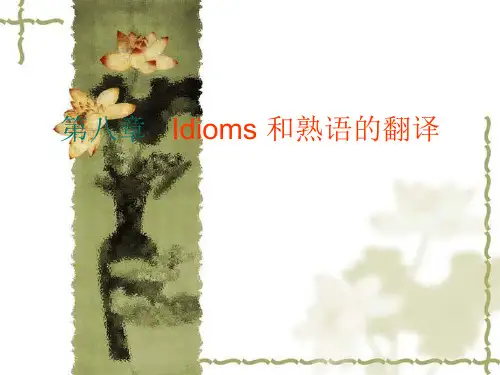


各类英文词典介绍及推荐希望能够给找寻字典的人一点基本的认识,希望对你有所帮助.想学好语言, 词典是毕不可少的工具、伙伴加老师。
如何选择一本或几本得心应手的词典, 是一个十分重要的问题。
一本好的词典会使你事半功倍, 而一本质量粗糙的字典也会令你不知所云。
因而作为一名英语学习者, 应该具备一点关于词典的知识, 这样就可以在众多的词典里选到有用且质量上乘的词典。
这里简单向大家介绍一些有用的知识, 以及几本好的词典。
英文字典的种类很多, 有综合词典、学术词典、专门词典、学生词典等, 下面便对这四种词典做一下介绍。
1.综合词典(general-purpose dictionary)综合词典的范围很广, 即使被称为“综合词典”, 每本词典也是以一定范围的读者为目标的。
一般收五万词条左右的是袖珍字典, 七八万词条的是简明字典。
十五万词条左右的是中型词典, 二十万词条以上的是大型词典。
2.学术性词典(scholarly dictionary)学术性词典以其大而全为特征。
最为突出的是《牛津英语词典》和其美国的姐妹篇A Dictionary of American English on Historical Principle《按照历史原则编纂的美国英语词典》。
3.专门词典(specialized dictionary)专门词典的种类繁多, 几乎关于词汇的每一领域都有专门词典。
例如:词源词典(其中最为有名的Walter W. Skeat编的Etymological Dictionary of English Language 和Charles T. Onions编的The Oxford Dictionary of English Etymology)。
同义词词典(例如:A Dictionary of English Synonymous Expressions, Webster's Dictionary of Synonyms)。
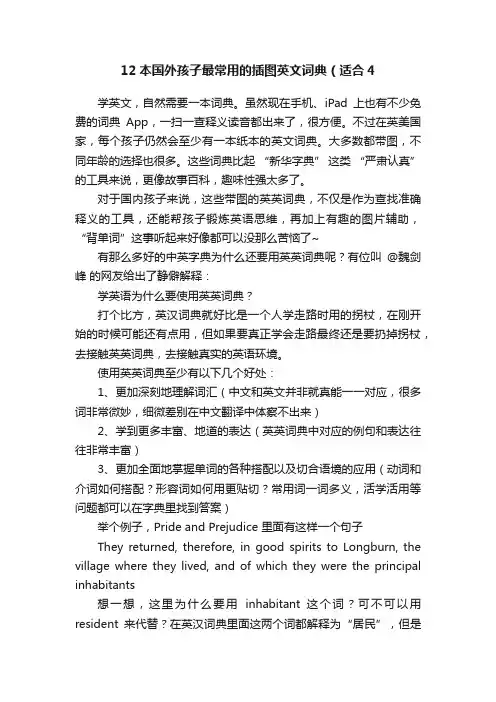
12本国外孩子最常用的插图英文词典(适合4学英文,自然需要一本词典。
虽然现在手机、iPad上也有不少免费的词典App,一扫一查释义读音都出来了,很方便。
不过在英美国家,每个孩子仍然会至少有一本纸本的英文词典。
大多数都带图,不同年龄的选择也很多。
这些词典比起“新华字典” 这类“严肃认真” 的工具来说,更像故事百科,趣味性强太多了。
对于国内孩子来说,这些带图的英英词典,不仅是作为查找准确释义的工具,还能帮孩子锻炼英语思维,再加上有趣的图片辅助,“背单词”这事听起来好像都可以没那么苦恼了~有那么多好的中英字典为什么还要用英英词典呢?有位叫@魏剑峰的网友给出了静僻解释:学英语为什么要使用英英词典?打个比方,英汉词典就好比是一个人学走路时用的拐杖,在刚开始的时候可能还有点用,但如果要真正学会走路最终还是要扔掉拐杖,去接触英英词典,去接触真实的英语环境。
使用英英词典至少有以下几个好处:1、更加深刻地理解词汇(中文和英文并非就真能一一对应,很多词非常微妙,细微差别在中文翻译中体察不出来)2、学到更多丰富、地道的表达(英英词典中对应的例句和表达往往非常丰富)3、更加全面地掌握单词的各种搭配以及切合语境的应用(动词和介词如何搭配?形容词如何用更贴切?常用词一词多义,活学活用等问题都可以在字典里找到答案)举个例子,Pride and Prejudice 里面有这样一个句子They returned, therefore, in good spirits to Longburn, the village where they lived, and of which they were the principal inhabitants想一想,这里为什么要用inhabitant 这个词?可不可以用resident来代替?在英汉词典里面这两个词都解释为“居民”,但是在英英词典里面这两个词的解释分别是:inhabitantn. [C]one of the people who live in a particular place.residentn.[C]someone who lives or stays in a place such as a house or hotel.两者一比较就能看出它们的细微差别了,一个是表示“居民“,一个是“住民”。
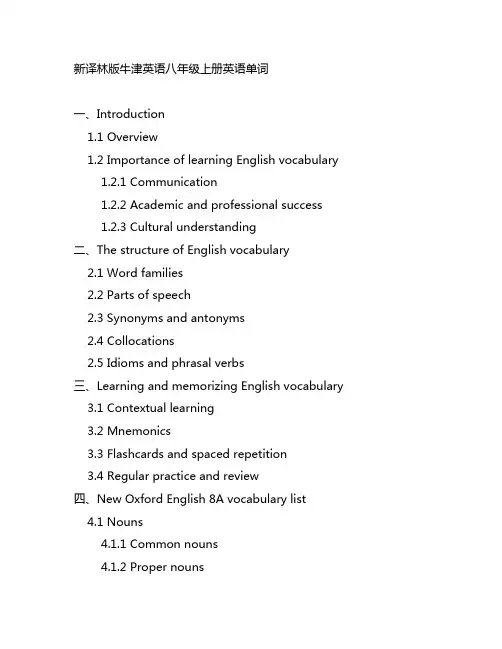
新译林版牛津英语八年级上册英语单词一、Introduction1.1 Overview1.2 Importance of learning English vocabulary 1.2.1 Communication1.2.2 Academic and professional success1.2.3 Cultural understanding二、The structure of English vocabulary2.1 Word families2.2 Parts of speech2.3 Synonyms and antonyms2.4 Collocations2.5 Idioms and phrasal verbs三、Learning and memorizing English vocabulary3.1 Contextual learning3.2 Mnemonics3.3 Flashcards and spaced repetition3.4 Regular practice and review四、New Oxford English 8A vocabulary list4.1 Nouns4.1.1 Common nouns4.1.2 Proper nouns4.1.3 Countable and uncountable nouns4.2 Verbs4.2.1 Regular verbs4.2.2 Irregular verbs4.2.3 Modal verbs4.3 Adjectives4.3.1 Adjectives to describe personality4.3.2 Adjectives to describe appearance4.4 Adverbs4.4.1 Adverbs of manner4.4.2 Adverbs of frequency4.5 Phrases and expressions五、Tips for effective vocabulary acquisition5.1 Reading extensively5.2 Keeping a vocabulary journal5.3 Using English in d本人ly life5.4 Engaging in meaningful conversations六、Conclusion6.1 Recap of the importance of English vocabulary6.2 Encouragement for continuous learning6.3 Suggestions for further resources and practice以上是新译林版牛津英语八年级上册英语单词的内容,学习英语单词要多多练习,才能更好地掌握英语单词。
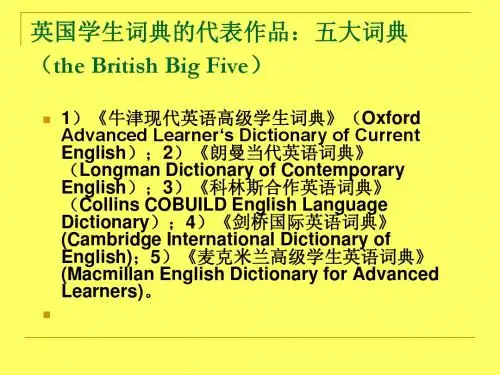
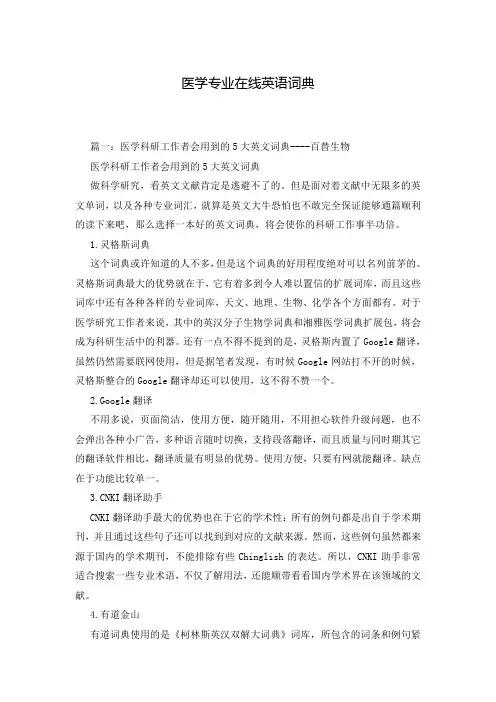
医学专业在线英语词典篇一:医学科研工作者会用到的5大英文词典----百替生物医学科研工作者会用到的5大英文词典做科学研究,看英文文献肯定是逃避不了的。
但是面对着文献中无限多的英文单词,以及各种专业词汇,就算是英文大牛恐怕也不敢完全保证能够通篇顺利的读下来吧,那么选择一本好的英文词典,将会使你的科研工作事半功倍。
1.灵格斯词典这个词典或许知道的人不多,但是这个词典的好用程度绝对可以名列前茅的。
灵格斯词典最大的优势就在于,它有着多到令人难以置信的扩展词库,而且这些词库中还有各种各样的专业词库,天文、地理、生物、化学各个方面都有。
对于医学研究工作者来说,其中的英汉分子生物学词典和湘雅医学词典扩展包,将会成为科研生活中的利器。
还有一点不得不提到的是,灵格斯内置了Google翻译,虽然仍然需要联网使用,但是据笔者发现,有时候Google网站打不开的时候,灵格斯整合的Google翻译却还可以使用,这不得不赞一个。
2.Google翻译不用多说,页面简洁,使用方便,随开随用,不用担心软件升级问题,也不会弹出各种小广告,多种语言随时切换,支持段落翻译,而且质量与同时期其它的翻译软件相比,翻译质量有明显的优势。
使用方便,只要有网就能翻译。
缺点在于功能比较单一。
KI翻译助手CNKI翻译助手最大的优势也在于它的学术性:所有的例句都是出自于学术期刊,并且通过这些句子还可以找到到对应的文献来源。
然而,这些例句虽然都来源于国内的学术期刊,不能排除有些Chinglish的表达。
所以,CNKI助手非常适合搜索一些专业术语,不仅了解用法,还能顺带看看国内学术界在该领域的文献。
4.有道金山有道词典使用的是《柯林斯英汉双解大词典》词库,所包含的词条和例句紧跟现代生活。
有道的功能比较全面,带很多扩展功能,包括全文翻译、屏幕取词、划词翻译、例句搜索、网络释义、真人语音朗读等。
还可将单词存入生词本,依靠云同步随时复习,适合词汇量积累。
不好的地方就是,比较占系统内存,小广告多。
The Oxford 3000 wordlist▪a, an indefinite article ▪abandon v.▪abandoned adj.▪ability n.▪able adj.▪unable adj.▪about adv.,prep.▪above prep.,adv.▪abroad adv.▪absence n.▪absent adj.▪absolute adj.▪absolutely adv.▪absorb v.▪abuse n.,v.▪academic adj.▪accent n.▪accept v.▪acceptable adj.▪unacceptable adj.▪access n.▪accident n.▪by accident▪accidental adj.▪accidentally adv.▪accommodation n.▪accompany v.▪according to prep.▪account n.,v.▪accurate adj.▪accurately adv.▪accuse v.▪achieve v.▪achievement n.▪acid n.▪acknowledge v.▪acquire v.▪across adv.,prep.▪act n.,v.▪action n.▪take action▪active adj.▪actively adv.▪activity n.▪actor, actress n.▪actual adj.▪actually adv.▪ad advertisement▪adapt v.▪add v.▪addition n.▪in addition (to)▪additional adj.▪address n.,v.▪adequate adj.▪adequately adv.▪adjust v.▪admiration n.▪admire v.▪admit v.▪adopt v.▪adult n.,adj.▪advance n.,v.▪advanced adj.▪in advance▪advantage n.▪take advantage of▪adventure n.▪advertise v.▪advertising n.▪advertisement (also ad, advert) n.▪advice n.▪advise v.▪affair n.▪affect v.▪affection n.▪afford v.▪afraid adj.▪after prep.,conj.,adv.▪afternoon n.▪afterwards (especially BrE; NAmE usually afterward) adv.▪again adv.▪against prep.▪age n.▪aged adj.▪agency n.▪agent n.▪aggressive adj.▪ago adv.▪agree v.▪agreement n.▪ahead adv.▪aid n.,v.▪aim n.,v.▪air n.▪aircraft n.▪airport n.▪alarm n.,v.▪alarming adj.▪alarmed adj.▪alcohol n.▪alcoholic adj., n.▪alive adj.▪all det.,pron.,adv.▪allow v.▪all right adj.,adv.,exclamation▪ally n., v.▪allied adj.▪almost adv.▪alone adj.,adv.▪along prep.,adv.▪alongside prep.,adv.▪aloud adv.▪alphabet n.▪alphabetical adj.▪alphabetically adv.▪already adv.▪also adv.▪alter v.▪alternative n.,adj.▪alternatively adv.▪although conj.▪altogether adv.▪always adv.▪ a.m. (NAmE also A.M.) abbr.▪amaze v.▪amazing adj.▪amazed adj.▪ambition n.▪ambulance n.▪among (also amongst) prep.▪amount n., v.▪amuse v.▪amusing adj.▪amused adj.▪an a, an▪analyse (BrE) (NAmE analyze) v.▪analysis n.▪ancient adj.▪and conj.▪anger n.▪angle n.▪angry adj.▪angrily adv.▪animal n.▪ankle n.▪anniversary n.▪announce v.▪annoy v.▪annoying adj.▪annoyed adj.▪annual adj.▪annually adv.▪another det.,pron.▪answer n.,v.▪anti- prefix▪anticipate v.▪anxiety n.▪anxious adj.▪anxiously adv.▪any det.,pron.,adv.▪anyone (also anybody) pron.▪anything pron.▪anyway adv.▪anywhere adv.▪apart adv.▪apart from (also aside from especially in NAmE) prep.▪apartment n. (especially NAmE)▪apologize (BrE also -ise) v.▪apparent adj.▪apparently adv.▪appeal n.,v.▪appear v.▪appearance n.▪apple n.▪application n.▪apply v.▪appoint v.▪appointment n.▪appreciate v.▪approach v.,n.▪appropriate adj.▪approval n.▪approve (of) v.▪approving adj.▪approximate adj.▪approximately adv.▪April n. (abbr. Apr.)▪area n.▪argue v.▪argument n.▪arise v.▪arm n.,v.▪arms n.▪armed adj.▪army n.▪around adv.,prep.▪arrange v.▪arrangement n.▪arrest v.,n.▪arrival n.▪arrive v.▪arrow n.▪art n.▪article n.▪artificial adj.▪artificially adv.▪artist n.▪artistic adj.▪as prep.,adv.,conj.▪ashamed adj.▪aside adv.▪aside from apart from ▪ask v.▪asleep adj.▪fall asleep▪aspect n.▪assist v.▪assistance n.▪assistant n.,adj.▪associate v.▪associated with▪association n.▪assume v.▪assure v.▪at prep.▪atmosphere n.▪atom n.▪attach v.▪attached adj.▪attack n.,v.▪attempt n.,v.▪attempted adj.▪attend v.▪attention n.▪pay attention▪attitude n.▪attorney n. (especially NAmE)▪attract v.▪attraction n.▪attractive adj.▪audience n.▪August n. (abbr. Aug.)▪aunt n.▪author n.▪authority n.▪automatic adj.▪automatically adv.▪autumn n. (especially BrE)▪available adj.▪average adj.,n.▪avoid v.▪awake adj.▪award n.,v.▪aware adj.▪away adv.▪awful adj.▪awfully adv.▪awkward adj.▪awkwardly adv.▪baby n.▪back n.,adj.,adv.,v.▪background n.▪backwards (also backward especially in NAmE) adv.▪backward adj.▪bacteria n.▪bad adj.▪go bad▪badly adv.▪bad-tempered adj.▪bag n.▪baggage n. (especially NAmE)▪bake v.▪balance n.,v.▪ball n.▪ban v.,n.▪band n.▪bandage n., v.▪bank n.▪bar n.▪bargain n.▪barrier n.▪base n.,v.▪based on▪basic adj.▪basically adv.▪basis n.▪bath n.▪bathroom n.▪battery n.▪battle n.▪bay n.▪be v.,auxiliary v.▪beach n.▪beak n.▪bear v.▪beard n.▪beat n.,v.▪beautiful adj.▪beautifully adv.▪beauty n.▪because conj.▪because of prep.▪become v.▪bed n.▪bedroom n.▪beef n.▪beer n.▪before prep.,conj.,adv.▪begin v.▪beginning n.▪behalf n.: on behalf of sb, on sb’s behalf (BrE) (NAmE in behalf of sb, in sb’s behalf)▪behave v.▪behaviour (BrE) (NAmE behavior) n.▪behind prep.,adv.▪belief n.▪believe v.▪bell n.▪belong v.▪below prep.,adv.▪belt n.▪bend v.,n.▪bent adj.▪beneath prep.,adv.▪benefit n.,v.▪beside prep.▪bet v.,n.▪betting n.▪better, best good, well▪between prep.,adv.▪beyond prep.,adv.▪bicycle (also bike) n.▪bid v.,n.▪big adj.▪bill n.▪bin n. (BrE)▪biology n.▪bird n.▪birth n.▪give birth (to)▪birthday n.▪biscuit n. (BrE)▪bit n. (especially BrE)▪ a bit▪bite v.,n.▪bitter adj.▪bitterly adv.▪black adj.,n.▪blade n.▪blame v.,n.▪blank adj., n.▪blankly adv.▪blind adj.▪block n.,v.▪blonde adj., n., blond adj.▪blood n.▪blow v.,n.▪blue adj.,n.▪board n., v.▪on board▪boat n.▪body n.▪boil v.▪bomb n.,v.▪bone n.▪book n.,v.▪boot n.▪border n.▪bore v.▪boring adj.▪bored adj.▪born: be born v.▪borrow v.▪boss n.▪both det.,pron.▪bother v.▪bottle n.▪bottom n.,adj.▪bound adj.: bound to▪bowl n.▪box n.▪boy n.▪boyfriend n.▪brain n.▪branch n.▪brand n.▪brave adj.▪bread n.▪break v.,n.▪broken adj.▪breakfast n.▪breast n.▪breath n.▪breathe v.▪breathing n.▪breed v.,n.▪brick n.▪bridge n.▪brief adj.▪briefly adv.▪bright adj.▪brightly adv.▪brilliant adj.▪bring v.▪broad adj.▪broadly adv.▪broadcast v.,n.▪broken break▪brother n.▪brown adj.,n.▪brush n.,v.▪bubble n.▪budget n.▪build v.▪building n.▪bullet n.▪bunch n.▪burn v.▪burnt adj.▪burst v.▪bury v.▪bus n.▪bush n.▪business n.▪businessman, businesswoman n.▪busy adj.▪but conj.▪butter n.▪button n.▪buy v.▪buyer n.▪by prep.,adv.▪bye exclamation ▪ c abbr.cent▪cabinet n.▪cable n.▪cake n.▪calculate v.▪calculation n.▪call v.,n.▪be called▪calm adj.,v.,n.▪calmly adv.▪camera n.▪camp n.,v.▪camping n.▪campaign n.▪can modal v.,n.▪cannot▪could modal v.▪cancel v.▪cancer n.▪candidate n.▪candy n. (NAmE) ▪cap n.▪capable (of) adj.▪capacity n.▪capital n.,adj.▪captain n.▪capture v.,n.▪car n.▪card n.▪cardboard n.▪care n.,v.▪take care (of)▪care for▪career n.▪careful adj.▪carefully adv.▪careless adj.▪carelessly adv.▪carpet n.▪carrot n.▪carry v.▪case n.▪in case (of)▪cash n.▪cast v.,n.▪castle n.▪cat n.▪catch v.▪category n.▪cause n.,v.▪CD n.▪cease v.▪ceiling n.▪celebrate v.▪celebration n.▪cell n.▪cellphone (also cellular phone) n. (especially NAmE)▪cent n. (abbr. c, ct)▪centimetre (BrE) (NAmE centimeter) n. (abbr.cm)▪central adj.▪centre (BrE) (NAmE center) n.▪century n.▪ceremony n.▪certain adj.,pron.▪certainly adv.▪uncertain adj.▪certificate n.▪chain n., v.▪chair n.▪chairman, chairwoman n.▪challenge n.,v.▪chamber n.▪chance n.▪change v.,n.▪channel n.▪chapter n.▪character n.▪characteristic adj.,n.▪charge n.,v.▪in charge of▪charity n.▪chart n.,v.▪chase v.,n.▪chat v., n.▪cheap adj.▪cheaply adv.▪cheat v.,n.▪check v.,n.▪cheek n.▪cheerful adj.▪cheerfully adv.▪cheese n.▪chemical adj.,n.▪chemist n.▪chemist’s n. (BrE)▪chemistry n.▪cheque n. (BrE) (NAmE check) ▪chest n.▪chew v.▪chicken n.▪chief adj.,n.▪child n.▪chin n.▪chip n.▪chocolate n.▪choice n.▪choose v.▪chop v.▪church n.▪cigarette n.▪cinema n. (especially BrE)▪circle n.▪circumstance n.▪citizen n.▪city n.▪civil adj.▪claim v.,n.▪clap v., n.▪class n.▪classic adj.,n.▪classroom n.▪clean adj.,v.▪clear adj.,v.▪clearly adv.▪clerk n.▪clever adj.▪click v., n.▪client n.▪climate n.▪climb v.▪climbing n.▪clock n.▪close /kl??s, NAmE klo?s/ adj.▪closely adv.▪close /kl??z, NAmE kl??z/ v.▪closed adj.▪closet n. (especially NAmE) ▪cloth n.▪clothes n.▪clothing n.▪cloud n.▪club n.▪cm abbr.centimetre▪coach n.▪coal n.▪coast n.▪coat n.▪code n.▪coffee n.▪coin n.▪cold adj.,n.▪coldly adv.▪collapse v.,n.▪colleague n.▪collect v.▪collection n.▪college n.▪colour (BrE) (NAmE color) n., v.▪coloured (BrE) (NAmE colored) adj.▪column n.▪combination n.▪combine v.▪come v.▪comedy n.▪comfort n.,v.▪comfortable adj.▪comfortably adv.▪uncomfortable adj.▪command v.,n.▪comment n.,v.▪commercial adj.▪commission n., v.▪commit v.▪commitment n.▪committee n.▪common adj.▪in common▪commonly adv.▪communicate v.▪communication n.▪community n.▪company n.▪compare v.▪comparison n.▪compete v.▪competition n.▪competitive adj.▪complain v.▪complaint n.▪complete adj.,v.▪completely adv.▪complex adj.▪complicate v.▪complicated adj.▪computer n.▪concentrate v.▪concentration n.▪concept n.▪concern v.,n.▪concerned adj.▪concerning prep.▪concert n.▪conclude v.▪conclusion n.▪concrete adj.,n.▪condition n.▪conduct v.,n.▪conference n.▪confidence n.▪confident adj.▪confidently adv.▪confine v.▪confined adj.▪confirm v.▪conflict n.,v.▪confront v.▪confuse v.▪confusing adj.▪confused adj.▪confusion n.▪congratulations n.▪congress n.▪connect v.▪connection n.▪conscious adj.▪unconscious adj.▪consequence n.▪conservative adj.▪consider v.▪considerable adj.▪considerably adv.▪consideration n.▪consist of v.▪constant adj.▪constantly adv.▪construct v.▪construction n.▪consult v.▪consumer n.▪contact n.,v.▪contain v.▪container n.▪contemporary adj.▪content n.▪contest n.▪context n.▪continent n.▪continue v.▪continuous adj.▪continuously adv.▪contract n.,v.▪contrast n.,v.▪contrasting adj.▪contribute v.▪contribution n.▪control n.,v.▪in control (of)▪under control▪controlled adj.▪uncontrolled adj.▪convenient adj.▪convention n.▪conventional adj.▪conversation n.▪convert v.▪convince v.▪cook v.,n.▪cooking n.▪cooker n. (BrE)▪cookie n. (especially NAmE) ▪cool adj.,v.▪cope (with) v.▪copy n.,v.▪core n.▪corner n.▪correct adj.,v.▪correctly adv.▪cost n.,v.▪cottage n.▪cotton n.▪cough v.,n.▪coughing n.▪could can▪council n.▪count v.▪counter n.▪country n.▪countryside n.▪county n.▪couple n.▪ a couple▪courage n.▪course n.▪of course▪court n.▪cousin n.▪cover v.,n.▪covered adj.▪covering n.▪cow n.▪crack n.,v.▪cracked adj.▪craft n.▪crash n.,v.▪crazy adj.▪cream n.,adj.▪create v.▪creature n.▪credit n.▪credit card n.▪crime n.▪criminal adj.,n.▪crisis n.▪crisp adj.▪criterion n.▪critical adj.▪criticism n.▪criticize (BrE also -ise) v.▪crop n.▪cross n.,v.▪crowd n.▪crowded adj.▪crown n.▪crucial adj.▪cruel adj.▪crush v.▪cry v.,n.▪ct abbr.cent▪cultural adj.▪culture n.▪cup n.▪cupboard n.▪curb v.▪cure v.,n.▪curious adj.▪curiously adv.▪curl v.,n.▪curly adj.▪current adj.,n.▪currently adv.▪curtain n.▪curve n.,v.▪curved adj.▪custom n.▪customer n.▪customs n.▪cut v.,n.▪cycle n.,v.▪cycling n.▪dad n.▪daily adj.▪damage n.,v.▪damp adj.▪dance n.,v.▪dancing n.▪dancer n.▪danger n.▪dangerous adj.▪dare v.▪dark adj.,n.▪data n.▪date n.,v.▪daughter n.▪day n.▪dead adj.▪deaf adj.▪deal v.,n.▪deal with▪dear adj.▪death n.▪debate n.,v.▪debt n.▪decade n.▪decay n.,v.▪December n. (abbr. Dec.)▪decide v.▪decision n.▪declare v.▪decline n.,v.▪decorate v.▪decoration n.▪decorative adj.▪decrease v.,n.▪deep adj.,adv.▪deeply adv.▪defeat v.,n.▪defence (BrE) (NAmE defense) n.▪defend v.▪define v.▪definite adj.▪definitely adv.▪definition n.▪degree n.▪delay n.,v.▪deliberate adj.▪deliberately adv.▪delicate adj.▪delight n.,v.▪delighted adj.▪deliver v.▪delivery n.▪demand n.,v.▪demonstrate v.▪dentist n.▪deny v.▪department n.▪departure n.▪depend (on) v.▪deposit n.,v.▪depress v.▪depressing adj.▪depressed adj.▪depth n.▪derive v.▪describe v.▪description n.▪desert n.,v.▪deserted adj.▪deserve v.▪design n.,v.▪desire n.,v.▪desk n.▪desperate adj.▪desperately adv.▪despite prep.▪destroy v.▪destruction n.▪detail n.▪in detail▪detailed adj.▪determination n.▪determine v.▪determined adj.▪develop v.▪development n.▪device n.▪devote v.▪devoted adj.▪diagram n.▪diamond n.▪diary n.▪dictionary n.▪die v.▪dying adj.▪diet n.▪difference n.▪different adj.▪differently adv.▪difficult adj.▪difficulty n.▪dig v.▪dinner n.▪direct adj.,v.▪directly adv.▪direction n.▪director n.▪dirt n.▪dirty adj.▪disabled adj.▪disadvantage n.▪disagree v.▪disagreement n.▪disappear v.▪disappoint v.▪disappointing adj.▪disappointed adj.▪disappointment n.▪disapproval n.▪disapprove (of) v.▪disapproving adj.▪disaster n.▪disc (also disk, especially in NAmE) n.▪discipline n.▪discount n.▪discover v.▪discovery n.▪discuss v.▪discussion n.▪disease n.▪disgust v.,n.▪disgusting adj.▪disgusted adj.▪dish n.▪dishonest adj.▪dishonestly adv.▪disk n.▪dislike v.,n.▪dismiss v.▪display v.,n.▪dissolve v.▪distance n.▪distinguish v.▪distribute v.▪distribution n.▪district n.▪disturb v.▪disturbing adj.▪divide v.▪division n.▪divorce n.,v.▪divorced adj.▪do v.,auxiliary v.▪undo v.▪doctor n. (abbr. Dr, NAmE Dr.)▪document n.▪dog n.▪dollar n.▪domestic adj.▪dominate v.▪door n.▪dot n.▪double adj.,det.,adv.,n.,v.▪doubt n.,v.▪down adv.,prep.▪downstairs adv.,adj., n.▪downwards (also downward especially in NAmE) adv.▪downward adj.▪dozen n.,det.▪Dr (BrE) (also Dr. NAmE, BrE) abbr.doctor ▪draft n.,adj.,v.▪drag v.▪drama n.▪dramatic adj.▪dramatically adv.▪draw v.▪drawing n.▪drawer n.▪dream n.,v.▪dress n.,v.▪dressed adj.▪drink n.,v.▪drive v.,n.▪driving n.▪driver n.▪drop v.,n.▪drug n.▪drugstore n. (NAmE)▪drum n.▪drunk adj.▪dry adj.,v.▪due adj.▪due to▪dull adj.▪dump v.,n.▪during prep.▪dust n.,v.▪duty n.▪DVD n.▪each det.,pron.▪each other (also one another) pron.▪ear n.▪early adj.,adv.▪earn v.▪earth n.▪ease n.,v.▪east n.,adj.,adv.▪eastern adj.▪easy adj.▪easily adv.▪eat v.▪economic adj.▪economy n.▪edge n.▪edition n.▪editor n.▪educate v.▪educated adj.▪education n.▪effect n.▪effective adj.▪effectively adv.▪efficient adj.▪efficiently adv.▪effort n.▪ e.g. abbr.▪egg n.▪either det.,pron.,adv.▪elbow n.▪elderly adj.▪elect v.▪election n.▪electric adj.▪electrical adj.▪electricity n.▪electronic adj.▪elegant adj.▪element n.▪elevator n. (NAmE)▪else adv.▪elsewhere adv.▪email (also e-mail) n.,v.▪embarrass v.▪embarrassing adj.▪embarrassed adj.▪embarrassment n.▪emerge v.▪emergency n.▪emotion n.▪emotional adj.▪emotionally adv.▪emphasis n.▪emphasize (BrE also -ise) v.▪empire n.▪employ v.▪unemployed adj.▪employee n.▪employer n.▪employment n.▪unemployment n.▪empty adj.,v.▪enable v.▪encounter v.,n.▪encourage v.▪encouragement n.▪end n.,v.▪in the end▪ending n.▪enemy n.▪energy n.▪engage v.▪engaged adj.▪engine n.▪engineer n.▪engineering n.▪enjoy v.▪enjoyable adj.▪enjoyment n.▪enormous adj.▪enough det.,pron.,adv.▪enquiry (also inquiry especially in NAmE) n.▪ensure v.▪enter v.▪entertain v.▪entertaining adj.▪entertainer n.▪entertainment n.▪enthusiasm n.▪enthusiastic adj.▪entire adj.▪entirely adv.▪entitle v.▪entrance n.▪entry n.▪envelope n.▪environment n.▪environmental adj.▪equal adj.,n.,v.▪equally adv.▪equipment n.▪equivalent adj.,n.▪error n.▪escape v.,n.▪especially adv.▪essay n.▪essential adj.,n.▪essentially adv.▪establish v.▪estate n.▪estimate n.,v.▪etc. (full form et cetera)▪euro n.▪even adv.,adj.▪evening n.▪event n.▪eventually adv.▪ever adv.▪every det.▪everyone (also everybody) pron.▪everything pron.▪everywhere adv.▪evidence n.▪evil adj.,n.▪ex- prefix▪exact adj.▪exactly adv.▪exaggerate v.▪exaggerated adj.▪exam n.▪examination n.▪examine v.▪example n.▪excellent adj.▪except prep.,conj.▪exception n.▪exchange v.,n.▪in exchange (for) ▪excite v.▪exciting adj.▪excited adj.▪excitement n.▪exclude v.▪excluding prep.▪excuse n.,v.▪executive n.,adj.▪exercise n.,v.▪exhibit v., n.▪exhibition n.▪exist v.▪existence n.▪exit n.▪expand v.▪expect v.▪expected adj.▪unexpected adj.▪unexpectedly adv.▪expectation n.▪expense n.▪expensive adj.▪experience n.,v.▪experienced adj.▪experiment n.,v.▪expert n.,adj.▪explain v.▪explanation n.▪explode v.▪explore v.▪explosion n.▪export v.,n.▪expose v.▪express v.,adj.▪expression n.▪extend v.▪extension n.▪extensive adj.▪extent n.▪extra adj.,n.,adv.▪extraordinary adj.▪extreme adj.,n.▪extremely adv.▪eye n.▪face n.,v.▪facility n.▪fact n.▪factor n.▪factory n.▪fail v.▪failure n.▪faint adj.▪faintly adv.▪fair adj.▪fairly adv.▪unfair adj.▪unfairly adv.▪faith n.▪faithful adj.▪faithfully adv.▪Yours faithfully (BrE) ▪fall v.,n.▪fall over▪false adj.▪fame n.▪familiar adj.▪family n.,adj.▪famous adj.▪fan n.▪fancy v.,adj.▪far adv.,adj.▪further adj.▪farm n.▪farming n.▪farmer n.▪farther, farthest far▪fashion n.▪fashionable adj.▪fast adj.,adv.▪fasten v.▪fat adj.,n.▪father n.▪faucet n. (NAmE)▪fault n.▪favour (BrE) (NAmE favor) n.▪in favour/favor (of)▪favourite (BrE) (NAmE favorite) adj.,n.▪fear n.,v.▪feather n.▪feature n.,v.▪February n. (abbr. Feb.)▪federal adj.▪fee n.▪feed v.▪feel v.▪feeling n.▪fellow n.,adj.▪female adj.,n.▪fence n.▪festival n.▪fetch v.▪fever n.▪few det.,adj.,pron.▪ a few▪field n.▪fight v.,n.▪fighting n.▪figure n.,v.▪file n.▪fill v.▪film n.,v.▪final adj., n.▪finally adv.▪finance n.,v.▪financial adj.▪find v.▪find out sth▪fine adj.▪finely adv.▪finger n.▪finish v.,n.▪finished adj.▪fire n.,v.▪set fire to▪firm n.,adj.,adv.▪firmly adv.▪first det.,ordinal number,adv.,n.▪at first▪fish n.,v.▪fishing n.▪fit v.,adj.▪fix v.▪fixed adj.▪flag n.▪flame n.▪flash v.,n.▪flat adj.,n.▪flavour (BrE) (NAmE flavor) n.,v.▪flesh n.▪flight n.▪float v.▪flood n.,v.▪floor n.▪flour n.▪flow n.,v.▪flower n.▪flu n.▪fly v.,n.▪flying adj.,n.▪focus v.,n.▪fold v.,n.▪folding adj.▪follow v.▪following adj.,n.,prep.▪food n.▪foot n.▪football n.▪for prep.▪force n.,v.▪forecast n., v.▪foreign adj.▪forest n.▪forever (BrE also for ever) adv.▪forget v.▪forgive v.▪fork n.▪form n.,v.▪formal adj.▪formally adv.▪former adj.▪formerly adv.▪formula n.▪fortune n.▪forward (also forwards) adv.▪forward adj.▪found v.▪foundation n.▪frame n.,v.▪free adj.,v.,adv.▪freely adv.▪freedom n.▪freeze v.▪frozen adj.▪frequent adj.▪frequently adv.▪fresh adj.▪freshly adv.▪Friday n. (abbr. Fri.)▪fridge n. (BrE)▪friend n.▪make friends (with)▪friendly adj.▪unfriendly adj.▪friendship n.▪frighten v.▪frightening adj.▪frightened adj.▪from prep.▪front n.,adj.▪in front (of)▪frozen freeze▪fruit n.▪fry v., n.▪fuel n.▪full adj.▪fully adv.▪fun n.,adj.▪make fun of▪function n.,v.▪fund n.,v.▪fundamental adj.▪funeral n.▪funny adj.▪fur n.▪furniture n.▪further, furthest far▪future n.,adj.▪g abbr.gram▪gain v.,n.▪gallon n.▪gamble v.,n.▪gambling n.▪game n.▪gap n.▪garage n.▪garbage n. (especially NAmE) ▪garden n.▪gas n.▪gasoline n. (NAmE)▪gate n.▪gather v.▪gear n.▪general adj.▪generally adv.▪in general▪generate v.▪generation n.▪generous adj.▪generously adv.▪gentle adj.▪gently adv.▪gentleman n.▪genuine adj.▪genuinely adv.▪geography n.▪get v.▪get on▪get off▪giant n.,adj.▪gift n.▪girl n.▪girlfriend n.▪give v.▪give sth away▪give sth out▪give (sth) up▪glad adj.▪glass n.▪glasses n.▪global adj.▪glove n.▪glue n.,v.▪gm abbr.gram ▪go v.▪go down▪go up▪be going to▪goal n.▪god n.▪gold n.,adj.▪good adj.,n.▪good at▪good for▪goodbye exclamation,n.▪goods n.▪govern v.▪government n.▪governor n.▪grab v.▪grade n., v.▪gradual adj.▪gradually adv.▪grain n.▪gram (BrE also gramme) n. (abbr. g, gm) ▪grammar n.▪grand adj.▪grandchild n.▪granddaughter n.▪grandfather n.▪grandmother n.▪grandparent n.▪grandson n.▪grant v.,n.▪grass n.▪grateful adj.▪grave n.,adj.▪gray (NAmE) grey▪great adj.▪greatly adv.▪green adj.,n.▪grey (BrE) (NAmE usually gray) adj.,n.▪grocery (NAmE usually grocery store) n.▪groceries n.▪ground n.▪group n.▪grow v.▪grow up▪growth n.▪guarantee n.,v.▪guard n.,v.▪guess v.,n.▪guest n.▪guide n.,v.▪guilty adj.▪gun n.▪guy n.▪habit n.▪hair n.▪hairdresser n.▪half n.,det.,pron.,adv.▪hall n.▪hammer n.▪hand n.,v.▪handle v.,n.▪hang v.▪happen v.▪happiness n.▪unhappiness n.▪happy adj.▪happily adv.▪unhappy adj.▪hard adj.,adv.▪hardly adv.▪harm n.,v.▪harmful adj.▪harmless adj.▪hat n.▪hate v., n.▪hatred n.▪have v., auxiliary v.▪have to modal v.▪he pron.▪head n.,v.▪headache n.▪heal v.▪health n.▪healthy adj.▪hear v.▪hearing n.▪heart n.▪heat n.,v.▪heating n.▪heaven n.▪heavy adj.▪heavily adv.▪heel n.▪height n.▪hell n.▪hello exclamation,n.▪help v.,n.▪helpful adj.▪hence adv.▪her pron.,det.▪hers pron.▪here adv.▪hero n.▪herself pron.▪hesitate v.▪hi exclamation▪hide v.▪high adj.,adv.▪highly adv.▪highlight v.,n.▪highway n. (especially NAmE) ▪hill n.▪him pron.▪himself pron.▪hip n.▪hire v.,n.▪his det.,pron.▪historical adj.▪history n.▪hit v.,n.▪hobby n.▪hold v.,n.▪hole n.▪holiday n.▪hollow adj.▪holy adj.▪home n.,adv..▪homework n.▪honest adj.▪honestly adv.▪honour (BrE) (NAmE honor) n.▪in honour/honor of▪hook n.▪hope v.,n.▪horizontal adj.▪horn n.▪horror n.▪horse n.▪hospital n.▪host n.,v.▪hot adj.▪hotel n.▪hour n.▪house n.▪housing n.▪household n.,adj.▪how adv.▪however adv.▪huge adj.▪human adj.,n.▪humorous adj.▪humour (BrE) (NAmE humor) n.▪hungry adj.▪hunt v.▪hunting n.▪hurry v.,n.▪in a hurry▪hurt v.▪husband n.▪I pron.▪ice n.▪ice cream n.▪idea n.▪ideal adj.,n.▪ideally adv.▪identify v.▪identity n.▪i.e. abbr.▪if conj.▪ignore v.▪ill adj. (especially BrE) ▪illegal adj.▪illegally adv.▪illness n.▪illustrate v.▪image n.▪imaginary adj.▪imagination n.▪imagine v.▪immediate adj.▪immediately adv.▪immoral adj.▪impact n.▪impatient adj.▪impatiently adv.▪implication n.▪imply v.▪import n.,v.▪importance n.▪important adj.▪importantly adv.▪unimportant adj.▪impose v.▪impossible adj.▪impress v.▪impressed adj.▪impression n.▪impressive adj.▪improve v.▪improvement n.▪in prep.,adv.▪inability n.▪inch n.▪incident n.▪include v.▪including prep.▪income n.▪increase v.,n.▪increasingly adv.▪indeed adv.▪independence n.▪independent adj.▪independently adv.▪index n.▪indicate v.▪indication n.▪indirect adj.▪indirectly adv.▪individual adj.,n.▪indoors adv.▪indoor adj.▪industrial adj.▪industry n.▪inevitable adj.▪inevitably adv.▪infect v.▪infected adj.▪infection n.▪infectious adj.▪influence n.,v.▪inform v.▪informal adj.▪information n.▪ingredient n.▪initial adj.,n.▪initially adv.▪initiative n.▪injure v.▪injured adj.▪injury n.▪ink n.▪inner adj.▪innocent adj.▪inquiry enquiry▪insect n.▪insert v.▪inside prep.,adv.,n.,adj.▪insist (on) v.▪install v.▪instance n.▪for instance▪instead adv.▪instead of▪institute n.▪institution n.▪instruction n.▪instrument n.▪insult v.,n.▪insulting adj.▪insurance n.▪intelligence n.▪intelligent adj.▪intend v.▪intended adj.▪intention n.▪interest n.,v.▪interesting adj.▪interested adj.▪interior n.,adj.▪internal adj.▪international adj.▪Internet n.▪interpret v.▪interpretation n.▪interrupt v.▪interruption n.▪interval n.▪interview n.,v.▪into prep.▪introduce v.▪introduction n.▪invent v.▪invention n.▪invest v.▪investigate v.▪investigation n.▪investment n.。
牛津双阶英语词典In the realm of English language learning, the Oxford Bilingual Dictionary has always been a trusted companionfor millions of learners across the globe. Its unique dual-level approach, combining basic and advanced vocabulary, has made it a standout among dictionaries, catering to the diverse needs of learners at different proficiency levels. The Oxford Bilingual Dictionary is more than just a compilation of words and their meanings. It is a comprehensive resource that offers insights into language usage, cultural nuances, and grammatical patterns. The dictionary’s dual-level design allows beginners to access basic definitions and examples while more advanced learners can delve deeper into the nuances of language use, exploring synonyms, antonyms, and idiomatic expressions.One of the dictionary’s key strengths is its focus on practical language usage. It provides real-world examples that demonstrate how words are used in context, making it easier for learners to understand and apply their knowledge in actual conversations. The dictionary also includespronunciation guides, which are invaluable for learners who are striving to perfect their pronunciation skills.Moreover, the Oxford Bilingual Dictionary is regularly updated to reflect the latest developments in English language and culture. This ensures that learners have access to the most relevant and up-to-date information, enabling them to keep up with the evolving nature of the language.For learners who prefer digital resources, the Oxford Bilingual Dictionary is also available in electronic formats, such as mobile apps and online versions. These digital versions offer additional features like search functionality, voice recognition, and personalized learning tools, making it even more convenient for learners to access and use the dictionary.The versatility of the Oxford Bilingual Dictionary is another noteworthy aspect. It can be used by students preparing for exams, professionals seeking to enhance their vocabulary for work-related purposes, or even casual learners interested in exploring the richness of the English language. Its wide appeal is further reflected inthe fact that it is available in multiple languages,catering to the needs of learners from diverse linguistic backgrounds.In conclusion, the Oxford Bilingual Dictionary is a powerful tool that can greatly enhance the English language learning experience. Its dual-level approach, comprehensive coverage, and focus on practical usage make it an indispensable resource for learners at all levels. Whether you are a beginner or an advanced learner, the Oxford Bilingual Dictionary will be your loyal companion in your journey of exploring and mastering the English language.**牛津双阶英语词典:英语学习者的得力助手**在英语学习领域,牛津双阶英语词典一直是全球数百万学习者的信赖之选。
《牛津英语词典》里的中文词汇——锅贴、馄饨
曾泰元
【期刊名称】《英语学习》
【年(卷),期】2014()4
【摘要】《牛津英语词典》(The Oxford English Dictionary)依历史原则编纂,是英语世界最大、最权威的英语词典。
2010年底整合资源.更新条目、定义与书证后,以在线版的形态重新问世。
在线版的《牛津英语词典》收录了300个左右
源自中文的词汇,或音译(loanword)或借译(loan translation)。
【总页数】1页(P80-80)
【关键词】《牛津英语词典》;词汇;中文;ENGLISH;馄饨;2010年;历史原则;英语世界
【作者】曾泰元
【作者单位】东吴大学英文系
【正文语种】中文
【中图分类】H316
【相关文献】
1.《牛津英语词典》里的中文词汇——20世纪末、21世纪初的两个新词 [J], 曾
泰元
2.《牛津英语词典》里的中文词汇——美食篇 [J], 曾泰元
3.《牛津英语词典》里的中文词汇——元宵、薄饼 [J], 曾泰元
4.《牛津英语词典》里的中文词汇——推拿、赤脚医生 [J], 曾泰元
5.《牛津英语词典》里的中文词汇——20世纪末、21世纪初的两个新词 [J], 曾泰元
因版权原因,仅展示原文概要,查看原文内容请购买。